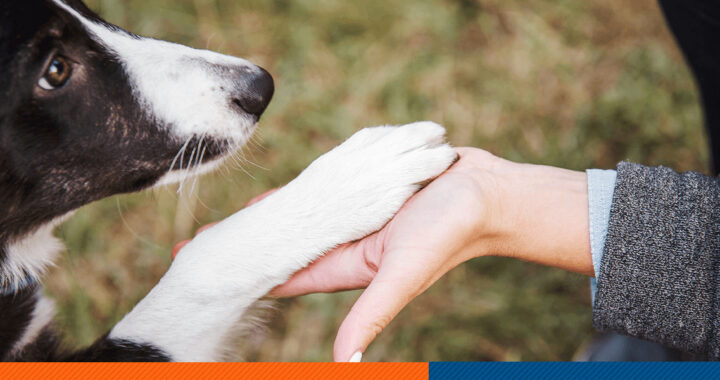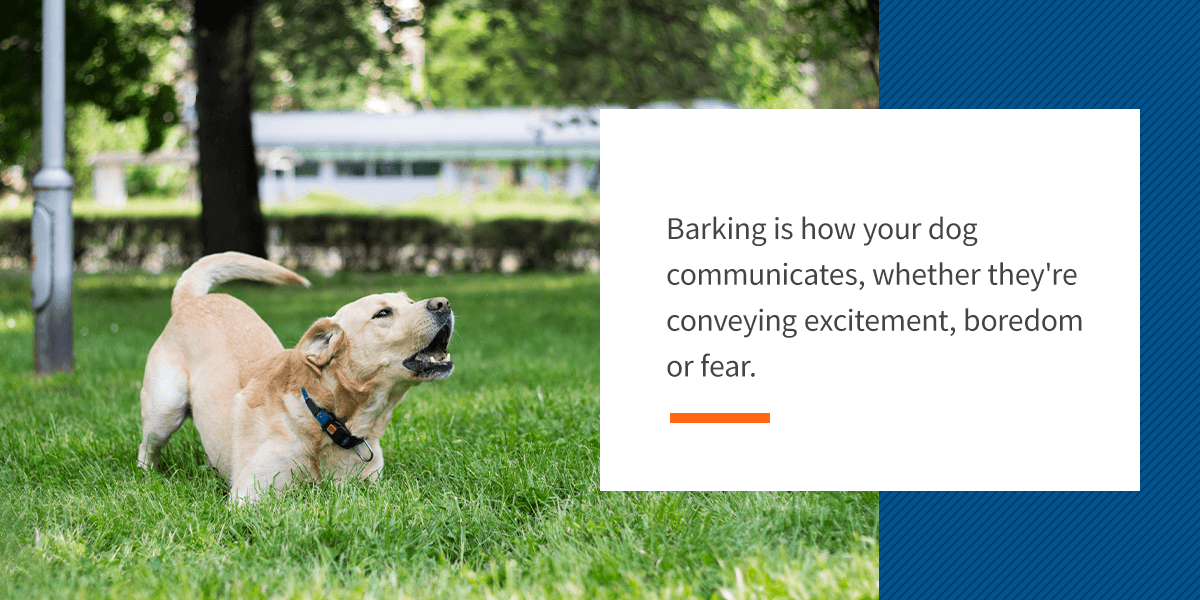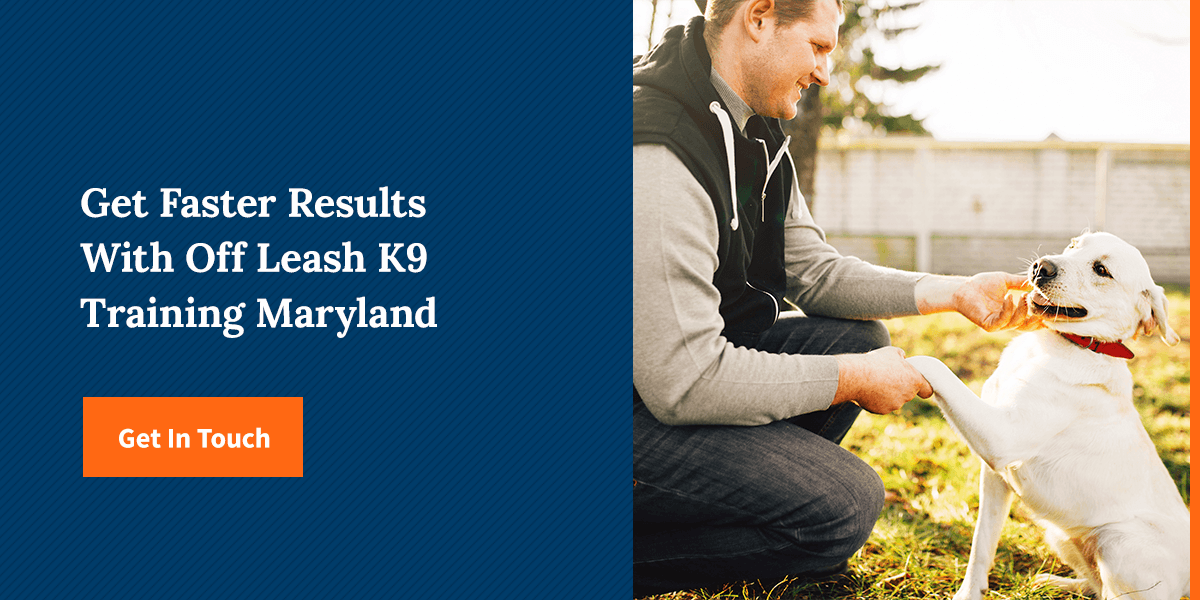Table of Contents
- How to Train Your Dog Not to Bark at Strangers
- How to Train Your Dog Not to Bark
- How to Train Your Dog Not to Bite
- Why Your Dog Has Separation Anxiety and How You Can Help
- Why Your Dog Is Aggressive and What to Do About It
- Get Faster Results With Off Leash K9 Training Maryland
A puppy’s socialization period begins when they’re three weeks old and continues until they are about 12 weeks old. During this time, you’ll want to expose your puppy to a wide variety of people, animals and places in a safe manner. Socializing your dog helps them become friendly and confident in new situations.
However, sometimes we find ourselves with a new best friend who missed early socialization or needs some extra help — and patience! In this guide, we discuss common socialization challenges, why our pups have these behaviors and what you can do about it.
How to Train Your Dog Not to Bark at Strangers
Your concern: “I want Oliver to behave around people. I’m wondering how to train my dog to ignore strangers.”
It’s natural for some dogs to get excited when they see strangers, but it’s not great if those strangers don’t want dogs to approach them. Make public outings less stressful by trying some of these training methods:
- Distract: The moment you notice your dog approaching strangers, use a toy to distract them, then reward them with a treat.
- Call: Divert your dog’s attention from others by calling their name. Reward them when they respond to you.
- Ignore: When a friend comes over for a visit, ask them to ignore your dog until they calm down. Then, ask your friend to award them with a treat for calming down.
- Focus: Practice the “sit” and “stay” commands with your pup, which you can use to make them stay away from strangers.
- Practice: Taking trips to populated areas will help your furry friend get used to seeing strangers. Eventually, the urge to greet people will become too tiring.
And here’s a quick bonus tip! Ask strangers not to pet your dog without asking first, especially if your dog is the one who’s not good with strangers.
How to Train Your Dog Not to Bark
Your concern: “I’m worried Poppy’s barking will annoy my neighbors. How do I train my dog not to bark?”
Barking is how your dog communicates, whether they’re conveying excitement, boredom or fear. Because there are many types of barking, you’ll need to know what’s causing the barking to stop it. Here are a few things you can try:
- Hand out toys: Distracting your pup with toys can help keep them busy.
- Use background noise: Putting on the TV, turning on the radio or playing white noise can distract dogs from outside noises, such as barking dogs.
- Teach quiet commands: Train your dog with quiet commands, such as “enough,” “quiet” or “hush.” Award them with a treat once they stop barking.
- Ignore it: Teach your dog that barking for your attention doesn’t work. Stop what you’re doing and ignore them or leave the area until they calm down.
- Exercise more: After a good workout, your pup will be less alert to external distractions and less likely to bother you for attention.
Even though persistent barking can be frustrating, try not to yell at your dog. Yelling at your dog to be quiet won’t reduce the barking, but it can trigger a fear response.
How to Train Your Dog Not to Bite
Your concern: “Bella nips my ankles every time I walk around the house. I want to know how to train my dog not to bite.”
Any dog can bite, but it mostly happens because of fear, frustration or protectiveness. Even though almost 81% of dog bites don’t require hospital visits, they can still hurt. Here are some training methods to lower their chance of biting:
- Bite inhibition: When your dog bites too hard during play, either give a high-pitched yelp or use a timeout procedure. Resume playtime after a few seconds.
- Noncontact play: Play fetch and tug-of-war rather than playing with your hands.
- Redirection: Use toys as a substitution or distraction when your pup tries to chew your toes.
- Body language: Before biting, pups may growl to show they’re frightened or upset. Give your dog space and remove them from the situation if they start to display uncomfortable body language.
- Obedience training: Use basic commands like “sit,” “stay,” “down” and “leave it” to keep your dog focused and teach impulse control in uncomfortable situations.
Also, keep in mind that dogs may lash out when in pain. You may want to take them to the vet to rule out medical reasons for biting.
Why Your Dog Has Separation Anxiety and How You Can Help
Your concern: “Max gets upset every time I leave the house. How can I help my dog feel calmer?”
Separation anxiety affects one in four to six dogs. Some anxious dogs howl or bark in excess when their owners leave the house. Here are a few different ways you can try to help them feel more at ease:
- Desensitization: Get your dog used to spending time alone. Start by leaving them for short periods of time and gradually increase their alone time.
- Counterconditioning: Change your dog’s perception of being alone from anxiety to excitement. You can do this by giving them special treats or food only when you leave.
- Disassociation: Do the actions linked to leaving throughout the day, like picking up your keys or putting on shoes, so your dog learns not to associate it with you leaving.
- Keep calm: Don’t make a big fuss when you leave or come back home. Stick to a simple pat on the head so they can calm down.
Separation anxiety doesn’t typically go away, but you can use these tips to ease your pup’s mind.
Why Your Dog Is Aggressive and What to Do About It
Your concern: “I’m worried about Buddy’s aggressive behavior. I’m trying to think how to train my aggressive dog so he won’t hurt anyone.”
First, you need to distinguish between a reactive dog and an aggressive one. A reactive dog is usually fearful due to a lack of training or bad experiences. They might become aggressive — determined to cause harm and destruction — as a result. Some tips on how to socialize a reactive dog may include:
- Keep track: Any dog can show aggressive behavior, so continue to track their patterns and triggers to determine the reason behind it.
- Positive reinforcement: Train your pup with treats to get used to different situations that cause them to react aggressively. Soon, your pup might associate the triggers with something positive!
- Focus commands: Teaching dogs commands like “leave it” and “out” can help curb their reactive behavior.
- Resource trading: Exchange the object your dog is guarding aggressively for a treat to distract them.
When guests come over, calmly but firmly tell them that your dog is working or training so they will respect your dog’s space.
Get Faster Results With Off Leash K9 Training Maryland
Remember that socialization is a gradual and continuous process that can be challenging for some dogs, even when they have a lot of practice. If you’re a dog owner in the Maryland area and feel like you need some encouragement, professional help or advice regarding your dog’s behavior, it’s time to find the right training program.
Off Leash K9 Training Maryland can help you come up with a training plan so that you don’t have to overcome these obstacles alone. We can help you and your dog — all you have to do is get in touch with us or call us at 443-743-3221 today.



